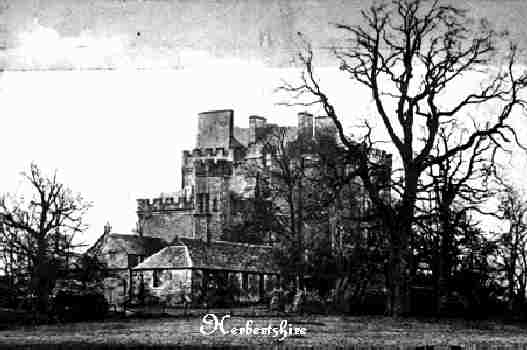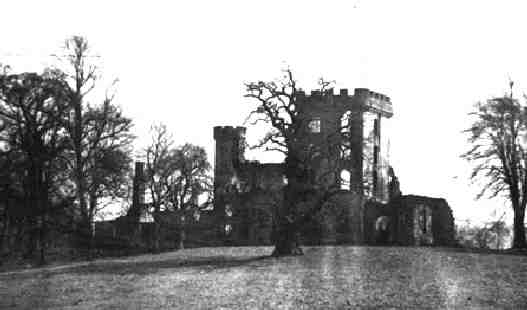



![]() Herbertshire was the last formidable estate in Scotland to be obtained and held by any of the Muirheads.(7.17)
Herbertshire was the last formidable estate in Scotland to be obtained and held by any of the Muirheads.(7.17)

Herbertshire Estate. ~ Source unknown.
![]() Herbertshire is believed to have taken its name from a man by the name of Herbert, who donated tracts of land in Dunipace to the Abbey of Cambuskenneth about the year 1200. Herbert was the son of Herbert de Camera. During the time that Herbert made the donations to the Abbey, the lands fell within the jurisdiction of the barony of Dunipace. After the donations, Herbertshire became the principal barony that remained. It was located within the county of Stirling.
Herbertshire is believed to have taken its name from a man by the name of Herbert, who donated tracts of land in Dunipace to the Abbey of Cambuskenneth about the year 1200. Herbert was the son of Herbert de Camera. During the time that Herbert made the donations to the Abbey, the lands fell within the jurisdiction of the barony of Dunipace. After the donations, Herbertshire became the principal barony that remained. It was located within the county of Stirling.
![]() The estate was known more properly as Herbertshire Castle. The castle was described in the book, Castellated And Domestic Architecture Of Scotland, published in 1889 by David MacGibbon and Thomas Ross as:(7.18)
The estate was known more properly as Herbertshire Castle. The castle was described in the book, Castellated And Domestic Architecture Of Scotland, published in 1889 by David MacGibbon and Thomas Ross as:(7.18)
| A large and lofty keep, situated near the village of Denny, in a park studded with ancient trees, overlooking the River Carron. It is of the first class as regards size, but it has been dreadfully knocked about and added to in the ‘castellated’ and other styles, to the great detriment of its appearance and interest. The structure is of the L Plan... and measures 63 feet 6 inches from north to south by 43 feet 8 inches from east to west, and the small limb of the L measures from east to west 26 feet 2 inches. Being now used as a school, the interior of the building has been greatly modernised. The View of the uppoer part of the castle from the east side... as seen rising over the confused modern buildings, is after the ordinary traditions of the Scottish castellated style. The parapet walk with angle turrets, and the massive chimney gable of the southern part of the sloping roof, with dormer window adjoining, and the turret and parapet resumed along the north side, make altogether a very effective composition. |
![]() The original structure is believed to have been built in the early part of the 14th Century by John Douglas, son of James, Lord Douglas. The barony and lands of Herbertshire were transferred by charter from Hugh Gifford, laird of Yester, to John Douglas during the reign of David II. John Douglas was killed by order of Sir David Barclay of Brechin some time before Shrove Tuesday in 1350. Herbertshire passed to another branch of the House of Douglas, and on 08 November 1388 the estate was transferred by charter from Archibald, 3rd Earl of Douglas and Lord of Galloway to his son, Sir William Douglas, Lord of Nithsdale. Sir William Douglas married the Princess Egidia, a daughter of King Robert II, and they bore a daughter, Egidia, who married Henry Sinclair, the 2nd Earl of Orkney in 1407.
The original structure is believed to have been built in the early part of the 14th Century by John Douglas, son of James, Lord Douglas. The barony and lands of Herbertshire were transferred by charter from Hugh Gifford, laird of Yester, to John Douglas during the reign of David II. John Douglas was killed by order of Sir David Barclay of Brechin some time before Shrove Tuesday in 1350. Herbertshire passed to another branch of the House of Douglas, and on 08 November 1388 the estate was transferred by charter from Archibald, 3rd Earl of Douglas and Lord of Galloway to his son, Sir William Douglas, Lord of Nithsdale. Sir William Douglas married the Princess Egidia, a daughter of King Robert II, and they bore a daughter, Egidia, who married Henry Sinclair, the 2nd Earl of Orkney in 1407.
![]() The estate of Herbertshire was granted by Archibald, 4th Earl of Douglas to Henry Sinclair 2nd Earl of Orkney and his wife, Egidia “the niece of the granter” on 17 November 1407. The grant of the property was, no doubt, a wedding gift to the young couple.
The estate of Herbertshire was granted by Archibald, 4th Earl of Douglas to Henry Sinclair 2nd Earl of Orkney and his wife, Egidia “the niece of the granter” on 17 November 1407. The grant of the property was, no doubt, a wedding gift to the young couple.
![]() Herbertshire was passed down through the Sinclair of Rosslyn line to a William Sinclair, who, in 1608, sold the barony of Herbertshire to Alexander Livingstone 1st Earl of Linlithgow. The estate passed from the Livingstone family to Sir John Blackadder of Tulliallan, who, in turn, granted it to John Stirling, son of William Stirling of Achyle in December 1632. The estate passed through the Stirling line until it reached George Stirling, the sixth laird of Herbertshire. George died without any children on 04 July 1760, and the estate passed to his sister, Jean Stirling. Jean sold the property to William Muirhead of Cavendish Square in the parish of St. Mary-le-bone, Westminster in 1768.
Herbertshire was passed down through the Sinclair of Rosslyn line to a William Sinclair, who, in 1608, sold the barony of Herbertshire to Alexander Livingstone 1st Earl of Linlithgow. The estate passed from the Livingstone family to Sir John Blackadder of Tulliallan, who, in turn, granted it to John Stirling, son of William Stirling of Achyle in December 1632. The estate passed through the Stirling line until it reached George Stirling, the sixth laird of Herbertshire. George died without any children on 04 July 1760, and the estate passed to his sister, Jean Stirling. Jean sold the property to William Muirhead of Cavendish Square in the parish of St. Mary-le-bone, Westminster in 1768.
![]() This William Muirhead, the new ‘laird of Herbertshire’ was a son of Robert Muirhead, and a grandson of John Muirhead, bailie of Lauchope. He had come into possession of a considerable amount of property when his father’s cousin, William Morehead (the first to change the spelling of the name) of Cavendish Square, London died. The new laird of Herbertshire, William, likewise changed the spelling of his name to Morehead about the same time.
This William Muirhead, the new ‘laird of Herbertshire’ was a son of Robert Muirhead, and a grandson of John Muirhead, bailie of Lauchope. He had come into possession of a considerable amount of property when his father’s cousin, William Morehead (the first to change the spelling of the name) of Cavendish Square, London died. The new laird of Herbertshire, William, likewise changed the spelling of his name to Morehead about the same time.
![]() William Morehead, the laird of Herbertshire, married Isabella, daughter of John Sinclair Lockhart of Castlehill and Camnethan in Lanarkshire in 1768. The couple took up residence in their newly acquired estate in that year and began raising a family that included at least three sons: William, John and Robert, along with a daughter: Charlotte Martha. William Morehead died in June of 1793, and the estate passed hands to his eldest son, William.
William Morehead, the laird of Herbertshire, married Isabella, daughter of John Sinclair Lockhart of Castlehill and Camnethan in Lanarkshire in 1768. The couple took up residence in their newly acquired estate in that year and began raising a family that included at least three sons: William, John and Robert, along with a daughter: Charlotte Martha. William Morehead died in June of 1793, and the estate passed hands to his eldest son, William.
![]() William Morehead 2nd laird of Herbertshire, married Marion Brown, daughter of T. Brown of Langside, Glasgow and the raised a family of three children: William, a son who died young, and Matilda. William Morehead died in March 1834. Two years prior to his death, William sold the estate of Herbertshire to his younger brother, the Reverend Robert Morehead, D.D.
William Morehead 2nd laird of Herbertshire, married Marion Brown, daughter of T. Brown of Langside, Glasgow and the raised a family of three children: William, a son who died young, and Matilda. William Morehead died in March 1834. Two years prior to his death, William sold the estate of Herbertshire to his younger brother, the Reverend Robert Morehead, D.D.
![]() Robert Morehead, the 3rd laird of Herbertshire, was born at Herbertshire on 19 March 1777. He received schooling at Chelsea and Southampton in England, then at Glasgow and Balliol College at Oxford. It was while attending Balliol College that Robert decided to go into the clergy. He took orders in the Church of England and became first, the Dean of Edinburgh and later, Rector of Easington, Yorkshire. Robert Morehead married Margaret Wilson on 27 November 1804 and they raised a family of four sons: William Ambrose, Charles, Robert Archibald Alison, and George Jeffrey.
Robert Morehead, the 3rd laird of Herbertshire, was born at Herbertshire on 19 March 1777. He received schooling at Chelsea and Southampton in England, then at Glasgow and Balliol College at Oxford. It was while attending Balliol College that Robert decided to go into the clergy. He took orders in the Church of England and became first, the Dean of Edinburgh and later, Rector of Easington, Yorkshire. Robert Morehead married Margaret Wilson on 27 November 1804 and they raised a family of four sons: William Ambrose, Charles, Robert Archibald Alison, and George Jeffrey.
![]() Robert Morehead evidently had planned on refurbishing the castle, because plans were drawn up by the architect, Robert Adams. The plans were subsequently deposited in the Soane Museum in London, but they were never carried out. The estate of Herbertshire remained in the hands of the Muirhead family for only sixty-eight years. In 1836 the Reverend Robert Morehead sold Herbertshire to William Forbes of Callendar, Stirlingshire. During the following year he noted in a letter that Herbertshire was “a mass of ruins, for [it] is remodelling.”
Robert Morehead evidently had planned on refurbishing the castle, because plans were drawn up by the architect, Robert Adams. The plans were subsequently deposited in the Soane Museum in London, but they were never carried out. The estate of Herbertshire remained in the hands of the Muirhead family for only sixty-eight years. In 1836 the Reverend Robert Morehead sold Herbertshire to William Forbes of Callendar, Stirlingshire. During the following year he noted in a letter that Herbertshire was “a mass of ruins, for [it] is remodelling.”

Herbertshire After The Fire. ~ Source unknown.
![]() Herbertshire remained in the hands of the Forbes family into the early part of the 1900s. It was destroyed by fire in the 1920s, and now stands as a ruin.
Herbertshire remained in the hands of the Forbes family into the early part of the 1900s. It was destroyed by fire in the 1920s, and now stands as a ruin.
7.17 Information in this section comes primarily from copies of a book supplied to Raymond Morehead by Carol Sneddon of the Falkirk Council. The title of the volume and its date of publication were not included with the copies.
7.18 Castellated And Domestic Architecture In Scotland, Volume 3, by David McGibbon and Thomas Ross 1889, pp 537-538.
